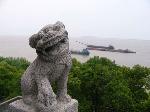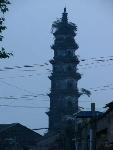- Getting around Lijiang. Dont stay in the Old Towns more than 2 days, there is nothing to do. KRISS Oct 9, 2013 05:46
- 2013 Beijing Temple Fair BENNYLAU Feb 26, 2013 03:29
- Malaysian traveling from KUL - LAX vis Shanghai PVG ZATI_DY Jan 3, 2013 20:15
What Remains of a Charming Town
- Views: 3648
- |Vote: 0 0
- |Add to Favorites
- |Recommend to Friends
China, Poorly Done
I'm no stranger to the gorgeous lakeside city of Yueyang. Five years ago I passed through the town, and was so taken by the face of its ancient shore that it stuck out in my memory as one of the most enchanting cities in the whole of China. This year, passing through Hunan once more, I insisted on stopping by to once again savour the poetic atmosphere of an unforgettable place. Unfortunately, I was to discover that Yueyang is no longer what it once was.
Just getting from the capital of the province, Changsha, to Yueyang was a struggle in itself. It was the middle of the May vacation when everyone's on the trains; it took an hour to queue for tickets and when it was finally time to get on board, the crowds were so thick that the carriages couldn't hold us all and many - including me - were sent away. I was seething - how could the station have sold so many tickets for a fully-booked train? Once again, as I have often been led to think before, I had to admit the dire planning responsible for the national train system. I spent an extra night in Changsha in a frightening railside inn, and finally got on a train - standing class only - way too early the next morning.
I've written perhaps a hundred articles on the subject of travel in China - but I'd never recommend anyone new to China to travel the same way I do, unless you're very, very thick skinned.
In any case, I was at last in the city I had so fondly remembered from years before. Leaving the station, however, I was rather disheartened to see that the 'new' city - the modernised areas away from the lake's edge - had grayed noticeably since my last visit. At that time, my guide book had told me that Yueyang was a quaint historical town with which the mark of economic progress had begun to make its play. This had been obvious when I visited in 2001 - the developed areas had already gathered in the centre of town and were standing in ugly, but unobtrusive counterpoint to the lake district. This time, it was obvious that rapid development had gathered as much dust and pollution as it has throughout the rest of the country in such centres, and I couldn't wait to get out to the shore.
The bus from the station turned the corner into the lakeside quarter, and my heart sank. All those lovely old homes - the walkways at the lake's edge - all those small stores I remembered - they'd all disappeared. Where they once were was a wasteland of brick and rubble. Evidently, and quite recently, the whole shoreline had been knocked flat. The bus chugged past the ruins, and I genuinely mourned for old Yueyang.
The Xuelian
Soon the bus arrived at my destination - thankfully, there to my left was the icon for which Yueyang is famous - the great Yueyang Tower, standing where it has, in various incarnations, for 1700 years. To my right still stood the most convenient, comfortable and economical hotel in the whole city - the Xuelian. Although not quite as budget as it once was, it still remains just as immaculate and cosy as before, and it is still ideally placed right in the centre of Yueyang's scenic district. Checking in to a large, clean room did much to improve my mood, as did the view of the tower and the lake from the balcony. Despite the eyesore of debris further along, at least this one enclave remained just as picturesque as it has since foreigners first arrived here in 1898 when Yueyang was opened as a remote and lovely treaty port.
Later in the afternoon, after a much-deserved period of recuperation from my train ordeal, I took the chance to stroll along the main road past the tower. A stretch of beautiful, ornate old stores faces the crimson boundary walls of the Yueyang Tower enclosure, and as I stopped to examine the merchandise, I was surprised to discover how cheap it all was. I asked one of the shopkeepers why she was selling at such a low price at peak travel season, and she replied glumly - "it's the closing down sale. Next week, this whole block will be torn down."
It turns out that the reason for all this wanton destruction is an attempt to increase the tourism potential of the tower. Plans on roadside billboards described the project - a massive reconstruction of the park surrounding the tower, with extra visiting halls, walkways, distractions, and scale replicas of the four previous towers, all constructed on the site in different historical periods. From the computer-generated depictions, I was interested to see that all five versions of the tower were based on the same layout - a three-tiered pagoda with broad, flourishing eaves and all built without the use of nails - and yet each version had unique features, making each tower as similar and as different as five brothers.
I continued to wander, if only to assess the damage to the other areas of Yueyang with which I was familiar. Many of the backstreets that had made Yueyang so charming for me were gone: a few, however, were thankfully unchanged and I retraced my steps to Yueyang's oldest monument, a tall, thin pagoda that survives in a small courtyard in an alleyway, from which locals now hang their clothing. The Cishi Tower was built centuries ago to appease the often violent mood-shifts of the lake waters; now the moss growing on its edges make it look like a towering pyramid of pot-plants.
Yueyang Lou Record
On my first trip to Yueyang, I'd balked at the high entry fee for the tower, and was content just to admire it from over the wall and enjoy instead the quaint charms and alleyways of the ancient quarter. Now, I was much more convinced of the value of seeing it up close, especially given the fact that the Yueyang I knew and loved was there no more.
For 46 yuan I was allowed to pass the gates I'd stopped short of before, and I got my first clear view of the tower. This present version was constructed in the Qing Dynasty, making it old enough to be impressive, even if it's not the original Song Dynasty structure once used by the ancient General Lu Su, who stood atop it to observe the military manoeuvers of his ships in around 215 A.D.
There are a couple of exhibition halls which tell the history of the tower and show ancient and modern art that take it as a subject - and featured prominently is an engraving of the famous poem Yueyang Lou Ji - the Yueyang Tower Record - which has really immortalised the tower and ensured its fame. The poem is a masterpiece of Chinese literature - written by famous poet fan Zhongyan almost a thousand years ago, it is now memorised by Chinese children today nationwide as an exemplary classic work of literature.
In the tower itself - which rests on great, scarlet pillars made of rare nanmu wood - the poem is engraved on tablets on the first and second stories. The third features a more recent work by Chairman Mao, who wrote his own verse about the tower. From this top level, the view of the lake is spectacular, and the two neighbouring structures can be examined from above - two smaller towers that are similar in style to the main structure and which celebrate an etching of a plum blossom and a drunken god, respectively.
I was very impressed with the look of the Yueyang Tower - inside, the polished red-stained enamel panelling and ebony-black classical Chinese furnishings created an austere and antiquated atmosphere that totally befitted such a building. I could see why this tower became the denizen of all poets and a holy ground for writers across the ages - many great names in the Chinese literary pantheon came here for inspiration, and as a writer myself it was a privilege to add my own humble name at the end of a distinguished list of authors who made their pilgrimages there.
There was only one disappointment - as I circled the balcony at the top level, I discovered something that shouldn't have been there - sticking out from one of the side beams was an old, rusted nail. It wasn't so much that it made something inauthentic out of the tower - I understood that the nails had been used in the construction of the tourist railings - but that the use of nails in a feat of architecture famed for avoiding them was just disrespectful. That was the summation of what had disappointed me about my whole trip to Yueyang this time - the renovations underway were impositions, and made without regard for the preservation of what makes Yueyang unique. Yueyang is still a great place to visit - it will be particularly impressive when all these renovations are completed - but the old mood of a tranquil town has been sacrificed in the process, and it's a great pity.






 Copyright © 1998-2025 All rights reserved.
Copyright © 1998-2025 All rights reserved.
1.
May 16, 2006 01:52 Reply
MISHEN said:
I'm sure that to the locals of Yueyang, these developments are improving their quality of life, providing more opportunities and giving access to modern-day luxuries. Sure, it's possible to make developments whilst still protecting sites of value, but it's unfair to expect that everyone has the same opinion of how best to do this, about which places are worth keeping (beautiful old homes may be awful to live in) and whether they can afford this kind of development anyway!
2.
May 14, 2006 18:16 Reply
PINETREE said:
Nice article.
Looks like China is not spared the price of development like all other countries. As foreigners, we often lament such a demise of the past but wonder whether this is how the locals feel ?